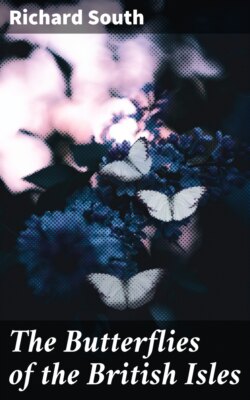Читать книгу The Butterflies of the British Isles - Richard South - Страница 16
На сайте Литреса книга снята с продажи.
The Large White (Pieris brassicæ).
ОглавлениеTable of Contents
This butterfly is probably almost as familiar to those who dwell in towns as it must be to those who live in the country. It is perhaps unnecessary to describe it in any detail, and it may therefore suffice to say that it is white with rather broad black tips to the fore wings; there are some black scales along the front margin of these wings, and on the basal area of all the wings. The male has a black spot on the front margin of the hind wings, and the female has, in addition, two roundish black spots on the fore wings, with a black dash from the lower one along the inner margin.
As there is a rather important difference between the specimens of the spring (vernal) and the summer (æstival) broods, figures of a male and a female of each brood, and showing the upper and under sides, are given. Those on Plate 6 represent the spring form, which was at one time considered to be a distinct species, and named chariclea by Stephens. Plate 9 shows the summer form. The chief point of difference is to be noted in the tips of the fore wings, which in the spring butterflies are usually, but not invariably, greyish; in the summer butterflies the tips are black, as a rule, but not in every case.
Occasionally the black on tip of the fore wing in the female is increased in width, and from it streaks project inwards towards the upper discal spot. In some examples of the male there is a more or less distinct blackish spot on the disc of the fore wings. Very rarely the ground colour is creamy or sulphur tinted.
The greenish tinge about the veins, sometimes seen in these butterflies, is due to some accidental cause, probably injury to the veins.
Larger Image
Pl. 6.
Large White Butterfly (Spring Brood)
1, 2 male; 3, 4 female.
Pl. 7.
Small White Butterfly
Resting.
The egg is yellowish in colour, somewhat skittle-shaped, and very prettily ribbed and reticulated. On Plate 5 there are two figures of the egg from enlarged drawings by Herr Max Gillmer, to whom I am greatly indebted for the loan of them. In the figure on the right, the dark spot at the shoulder of the egg represents the head of the young caterpillar, and in that on the left is seen the caterpillar about to come out of the egg. The head is already out, and the jaws have left their mark on the egg-shell. Most caterpillars of the Whites, as well as those of other butterflies, devour their egg-shells.
The eggs are laid in batches of from six to over one hundred in each batch. They are placed on end, and on either side of a leaf, chiefly cabbage. Herr Gillmer writes that he watched a female depositing her eggs on a leaf of white cabbage in the hot sunshine, and found that she laid twenty-seven in about nine minutes. A previous observer had timed a female, and noted that she produced eggs at the rate of about four in the minute. Caterpillars hatch from the egg in about seven days in the summer. The caterpillar (Plate 5) when full grown is green tinged with blue or grey above, and greenish beneath. There are numerous short whitish hairs arising from little warts on the back and sides; the lines are yellow. The caterpillars feed in July, and sometimes again in September and October, on all plants of the cabbage tribe, and also on tropæolum and mignonette. A number of these caterpillars may often be seen crowded together on a cabbage leaf, and they sometimes abound to such an extent that much loss is sustained by growers of this most useful vegetable. A peculiarity of these caterpillars is that even when not numerous, their presence is indicated by an evil smell that proceeds from them. The unpleasantness of the odour is greatly intensified if the caterpillars are trodden upon.
The chrysalis (Plate 5) is of a grey colour, more or less spotted with black and streaked with yellow. It is often to be seen fixed horizontally under the copings of walls, the top bar of a fence, or a window-sill; but it sometimes affects the upright position when fastened in the angle formed by two pales. A position that affords some measure of protection from weather is generally selected.
Although this butterfly is almost annually to be seen, in greater or lesser numbers, throughout the country, it is occasionally scarce, either generally or in some parts of the British Islands. For example, during the past year (1905) it was abnormally plentiful in Ireland, but at the same time comparatively rare in England. It is a migratory species, and no doubt its abundance in any year in these islands is dependent on the arrival of a large number of immigrants. Possibly in some years none of the migrant butterflies reach our shores, and that it is largely to this failure the rarity of the species in such years is to be attributed. Caterpillars resulting from alien butterflies may absolutely swarm in the autumn of one year, but the eccentricities of an English winter may be too much for the vitality of such of them as escape their enemies, Apanteles glomeratus, and other so-called "ichneumons," and reach the chrysalis state. So, with immigration on the one hand and destructive agencies on the other, it may be understood how it comes about that the Large White is sometimes abundant and sometimes scarce.
This species seems to range over the whole of the British Islands, with the exception, perhaps, of the Shetlands. Abroad, it has been found in all parts of the Palæarctic Region, except the extreme north, and Eastern Asia.
